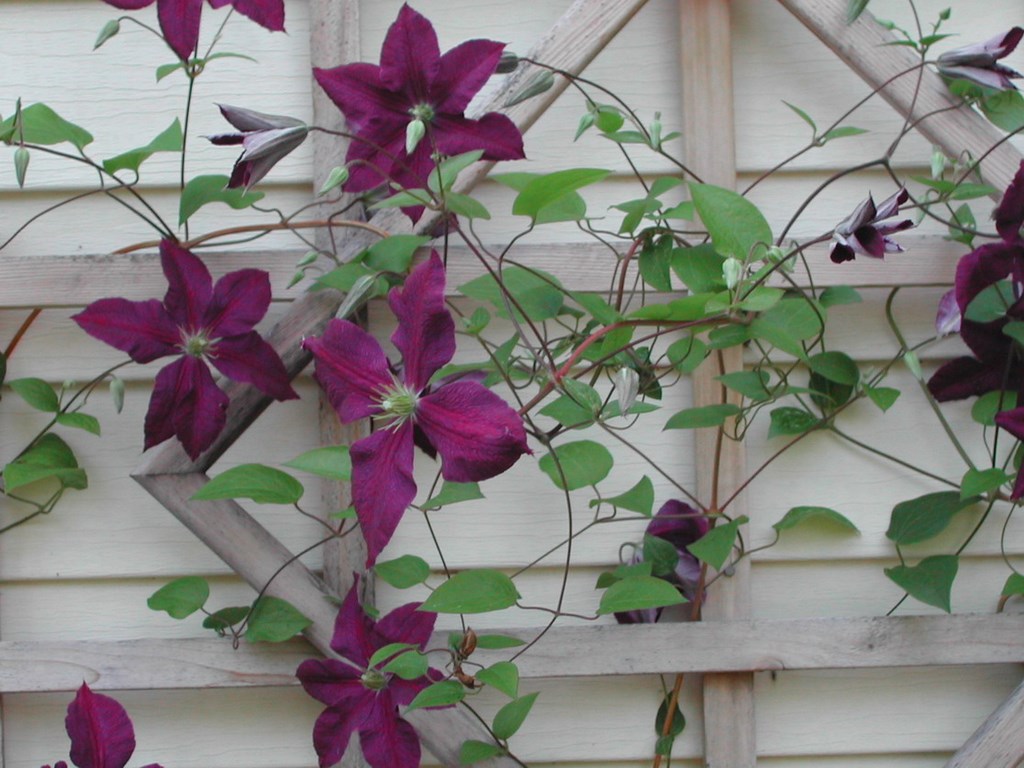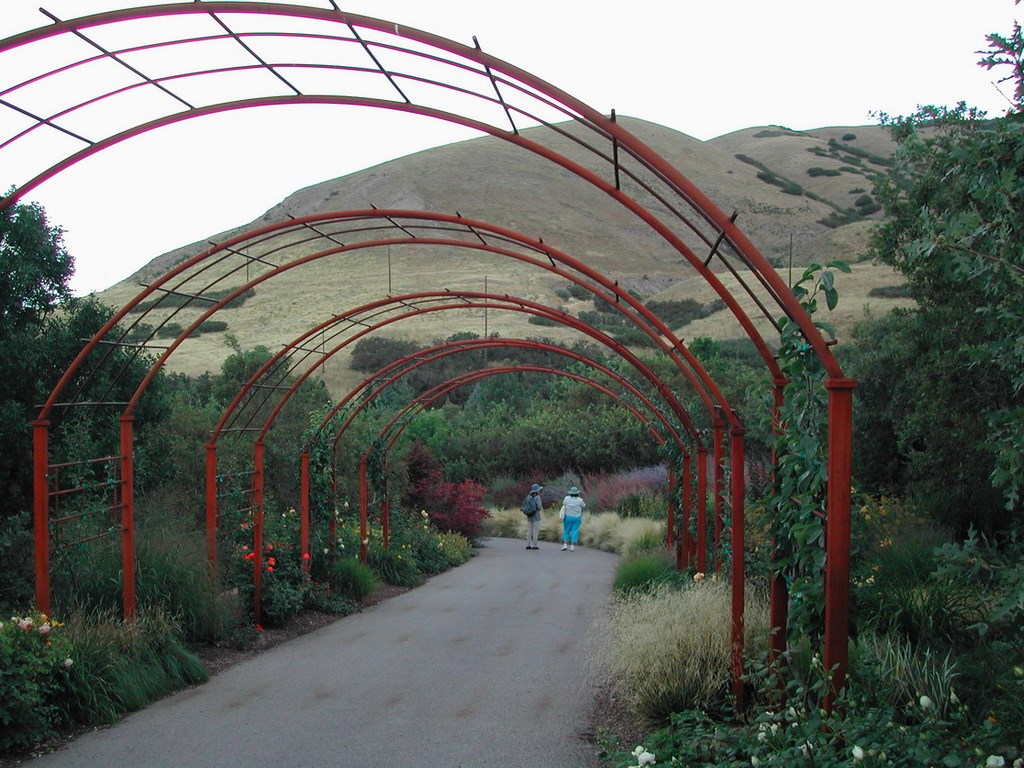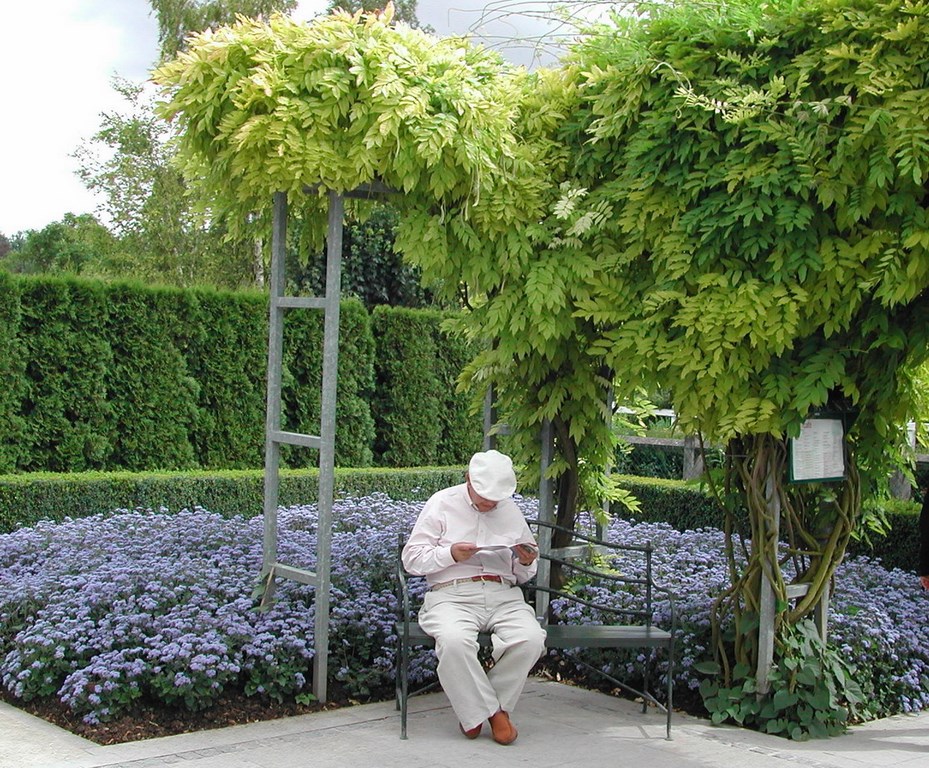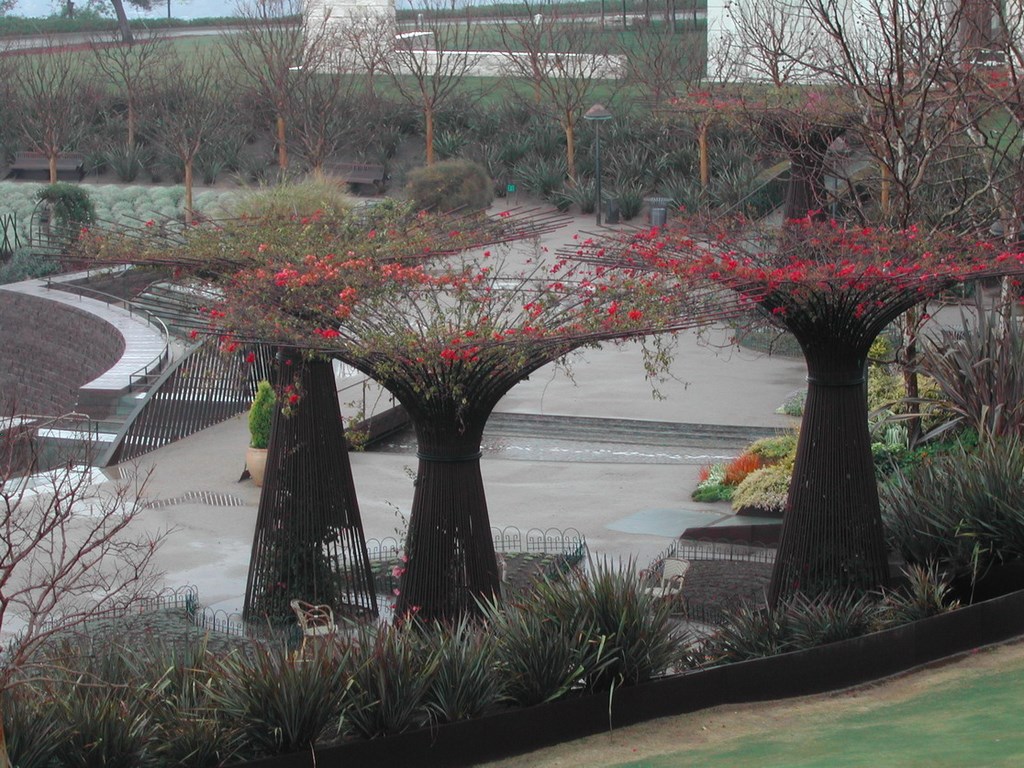Vertical Gardening

Inspiration – literally, the breath of an idea – can come from any number of sources.
While studying the work of 20th-century designer Beatrix Farrand at Dumbarton Oaks in Washington, D.C., for example, I spotted the planting combination of climbing pillar rose and Wisteria and thought her brilliant for having covered the woody Wisteria stems with rose flowers and foliage in that way.
Whether you pick these things up through classes, books or garden visits, studying the work of the masters yields many such gems, as does reviewing the cutting-edge gardens of today.
In my travels lately, I’ve been paying particular attention to the ways in which ornamental vines, both perennial and annual, have been used to add texture, flowers, berries, fragrance and sometimes fruit to garden structures ranging from arbors, pergolas and tunnels to bowers, trellises and lattice panels. Whether they serve as walls of outdoor rooms, as shady places of refuge or simply as inviting entry walks or doorways, the visual power of these structures is undeniable.
This type of planting, known as “vertical gardening,” has long been practiced in the United States (see the first sidebar below) and is recognized as the art of growing plants up and around garden structures. This art form plays a vital role in shaping garden spaces by adding flowers at eye level, extending the bloom sequence of the flowering landscape and beautifying buildings in striking and distinctive ways.
IN THE GARDEN
To illustrate the basic effects of vertical gardening, let’s start by imagining a garden as an outdoor room with walls, a ceiling, a floor, doors and windows with views and take a look at Figures 1, 2 and 3, which depict the before, during (with masonry installed) and after of one of my garden designs. What’s to come in this case is a full growth of vines to cover and enclose the structure – but we’re still imagining!
| Figure 1 (left), Figure 2 (middle) and Figure 3 (right). |
My intention here is to establish the pergola as an outdoor foyer with a stone carpet, living room and corridor. Climbing roses and Clematis have been planted at the base of the lattice panel and the outward posts, with Hydrangea petiolaris planted on the inward posts for shade. The beauty of this living plant material already softens and will eventually envelop a very special garden space, turning an awkward architectural area into an inviting, shady refuge.
| Figure 4 |
In other settings, we might think about using trellises as walls or vine-covered bowers to create cave-like structures. Indeed, bower/cave structures offer wonderful respite from searing summer heat – and exemplifies one of the archetypal spaces Julie Moir Messervy speaks of in her book, The Inward Garden: Creating a Place of Beauty and Meaning (Little, Brown & Company, 1995).
She defines these close spaces as the “first gardens of your life,” saying that by “exploring these universal spatial images, you will understand the most fundamental feelings and forms that you seek to build in your garden.” When a vine-covered pergola is situated with three walls, it becomes Messervy’s archetypical harbor, a space of refuge, a safe enclosure with a view out into the world or a place from which to study the garden at large.
|
Study Guide My exploration of our long history of vertical gardening has been greatly assisted by Restoring American Gardens: An Encyclopedia of Heirloom Ornamental Plants 1640-1940 by Denise Wiles Adams (Timber Press, 2004). Let me run through a couple of examples of what I found in her book as companions to my own thoughts on the nature and value of vertical gardening as expressed in the accompanying column. [ ] She offers a photo taken around 1900 of a Prairie-style home with sweet peas and morning glories growing on wires mounted on the side of the house. “Solon Robinson described the adornment of a log cabin where he stayed as a guest near Coffeeville, Mississippi, in 1845: ‘From that rude, block log cabin to the front gate, extended a neat arbor for the support of twining flowers, climbing vines and roses.’ ” These vines were the plants of choice for pioneers who had few luxuries and usually just one or two types of plants from which to choose. [ ] She depicts Queen Anne-style homes (popular from 1880 to 1910) with porches or verandas perfected by vine-supporting trellises. Beyond their beauty, the plants provided privacy and shade from the day’s heat – and are evidence of the association more than 100 years ago of certain garden styles with certain architectures. [ ] Adams discusses the fact that, for urban homes, the first ornamental plantings were typically vines used to cover fences – roles in which Honeysuckle, Boston Ivy or Dutchman’s Pipe served admirably. Later, she adds, annuals, perennials, roses, and urns of flowers joined the vines to complete front gardens. For the Colonial revival style (1880-1955), grapes, Wisteria, Woodbine or English Ivy were popularly and effectively planted in urban yards, with the vines used “to soften a hard line, to accentuate the beauty of a chimney, to make a porch part of the house, to lend color and texture to a wall.” [ ] As one would expect, each region has historically had favorite vines and uses of those vines. A formal garden depicted in New England Magazine in 1899, for instance, showed a garden plan with a Wisteria arbor as a prominent feature. Southern metropolitan gardens used vine-covered walls to enclose gardens “creating shade and a green canvas,” while a Florida gardener noted that the “verandah is wound with vines of Thunbergia and Maurandya, which are a mass of blooms continuously.” Another noted, “I have two large Wax vines growing over the door, forming an arch, which is very much admired.” [ ] With another voice from the past, Jared Kirtland (1845) urges the use of native plants: “The most homely log house with its portals covered with the ever-blooming Honeysuckle, and some of the climbing roses, its ends deeply enshrouded with the luxuriant grape vine and the running Ampelopsis, over-shadowed with the native trees, or those that are fruit-bearing, presents more pleasing associations than the gaudily painted farmhouse.” (It’s important to note that Ampelopsis may be banned in some states due to its invasive nature.)Revisiting Beatrix Ferrand, I note that she often used vertical gardening to great advantage. I’ve already mentioned her effective use of Wisteria sinensis and roses on an arbor at Dumbarton Oaks, and there’s also her work at Princeton University where, as late as 1984, wall plantings of Wisteria and Magnolia kobus still adorned campus buildings. “Wall plantings,” as Farrand called them, grow on structures that may define the walls of outdoor rooms or, in the way that she used them at Princeton, to define the walls of buildings themselves. Her vine of choice for the latter purpose was Boston Ivy – perfect, she said, for hiding ugly buildings. She also believed that well trained “wall shrubs” (her term for these vines) brought out rather than muffled a building’s character. While one doesn’t see this technique of wall shrubs employed much anymore, it’s my observation that vertical gardening of a different sort can add much to a garden’s structure and feeling of abundance. — M.v.B. |
Now consider a pergola as a tunnel leading to a destination or framing a view, near or far. Figure 4 (above) effectively illustrates this concept of “view framing” at Salt Lake City’s Red Butte Garden. The boldly painted metal arches will soon be covered with vines – and their structural function will be altogether different in winter, when foliage disappears from the visual landscape.
In this case, the arbor’s “ceiling” lowers the sky to human scale and then defines a place where the visitor emerges back into the open, with rolling hills visible in the distance. The vertical garden’s contribution to awareness of natural openness is important, creating a special experience as you use the path. And when the foliage is in place, visitors will be treated to a green ceiling of texture and fragrance.
APPLIED IMAGINATION
Arbors, arbor seats, pergolas and bowers can each be used to enclose spaces and, in essence, establish sanctuaries. For those of you with imagination, you might even be able to see using flowering vines and wall plants as vehicles of seduction.
Just that sort of atmosphere is conveyed by the Wisteria arbor in the gardens of the Musée d’art Américain in Giverny, France (Figure 5 below). Here, the arbor frames a view and creates an intimate sitting area within a grander outdoor room. (I still marvel at my luck in photographing a man dressed in white from head to toe in that space.) When in bloom, the Wisteria contrasts with the green hedge walls, while the colors of the vines complement and harmonize with the rest of the garden’s color palette.
| Figure 5 |
(On a purely practical note, at the Hayes Estate garden in New Hampshire I noticed that all the tall trellises were hinged at the base to allow painters to lay back the vine-laden trellises as they worked. Some kind of hinged foot moved out like the leg of a portable card table, suspending trellis and vine above the ground to protect the plants.)
Vine foliage and flowers often act as integral parts of beautiful plant combinations with respect to color, texture and form. Vertical gardening, however, encourages us to engage the senses using not only those three common elements, but also fragrance, sound and a sense of Messervy’s archetypal spaces because of their intimacy. Even the sense of taste might be included if a fruiting vine or an espaliered fruit tree is included.
It’s also possible to extend a vertical garden’s utility by thoughtfully combining early-, mid-, and late-blooming vines. Consider a purple, yellow, and white garden that features spring-blooming Clematis ‘Henryi’ followed by mid-summer yellow Tangutica combined with purple Clematis ‘x jackmanii’ – all to be followed by white Clematis ‘Sweet Autumn.’ Or how about a pink/white/purple palette starting with pale-pink Clematis montana rubens, followed by Rosa ‘New Dawn’ and purple-blue Clematis viticella ‘Polish Spirit’ along with Clematis ‘Henyri’ and Clematis ‘Sweet Autumn’?
| Figure 6 |
As for the support structures themselves, older gardens offer myriad examples of wood patterns for trellises and arbors. These structures not only have withstood the tests of time, but they also offer beautiful alternatives to the off-the-shelf products seen in too many gardens these days. Again, it’s all about inspiration.
And of course, the sky’s the limit if you truly set your imagination free – a case in point being the Bougainvillea arbors at the Getty Center in Los Angeles (Figure 6, at right), where the artist shaped the vines to function as trees and takes vertical gardening in another direction altogether.
LASTING IMAGES
For me, a beautiful garden does more than just create a pretty picture. Indeed, I believe that gardens can restore your smile.
|
Resources: Beatrix Ferrand’s American Landscapes: Her Gardens & Campuses by Diana Balmori, Diane Kostial McGuire and Eleanor M. McPeck (Sagapress, 1985) The Inward Garden: Creating a Place of Beauty and Meaning, by Julie Moir Messervy (Little Brown & Company, 1995) Restoring American Gardens: An Encyclopedia of Heirloom Ornamental Plants 1640-1940 by Denise Wiles Adams (Timber Press, 2004) — M.v.B. |
It works like this: First, you create a comfortable space that includes a sitting or “lingering” area, then use color and flowers to beckon people in and put plant combinations that capture their attention on display. Then you let viewers create their own sensations of wonder, harmony and connection with the seasonal and daily rhythms of earth and sky.
By incorporating vertical gardening into your design repertoire, you add an element to the garden that in most cases doesn’t naturally exist. This allows you to create images and sensations that go well beyond the mere shaping of visually pleasing gardens. And if you’re truly successful in doing so, the deeper breathing and relaxation that accompany the engagement of the senses will restore the spirits of all those who visit the space – and, we hope, affect them for the better.
Maria von Brincken, APLD, owns and operates a full-service landscape design practice in Sudbury, Mass. Her award winning work has been published in Fine Gardening and is featured in Front Yard Idea Book (Taunton Press). She has also been interviewed and quoted by national newspapers, has appeared on local television and gives lectures at garden clubs, symposiums and conferences. She can be reached at [email protected].
















